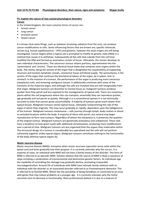Essay
P1 P2 P3 M1 Unit 14 Physiological Disorders Health and Social Care Level 3 Extended Diploma
- Institution
- Pearson (PEARSON)
P1: Explain the nature of two named physiological disorders (CANCER AND MND) P2: Explain the signs and symptoms related with two named physiological disorders P3: Describe the investigations that are carried out to enable the diagnosis of these physiological disorders M1: Assess the possible dif...
[Show more]




